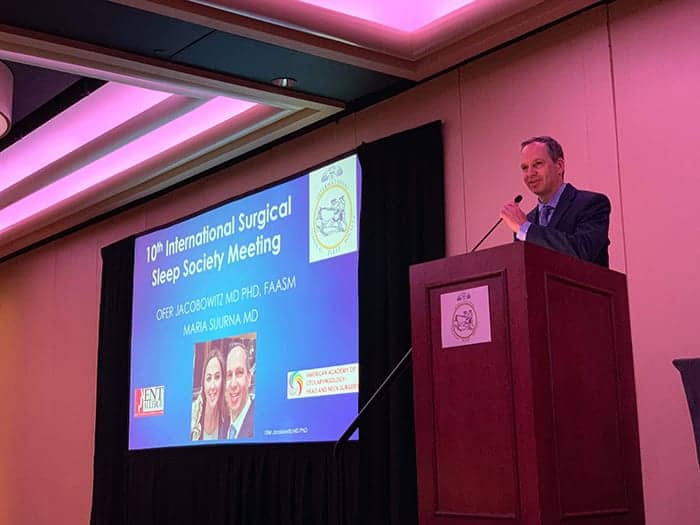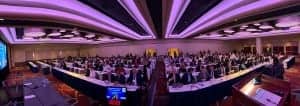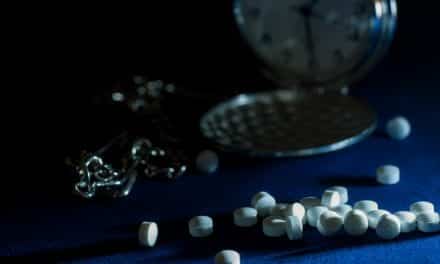The international sleep medicine community gathered in New York City to discuss hypoglossal neurostimulation therapy, personalized treatment of sleep apnea, snoring and much more.
Picture an international gathering of expert sleep apnea surgeons, sleep medicine specialists, and dental sleep medicine practitioners and you have the 10th International Surgical Sleep Society meeting that took place in New York City from May 9-11, 2019. About 400 attendees from 36 countries met to discuss the pathophysiology of obstructive sleep apnea (OSA), updates on current treatments, and future directions for OSA treatment. About 100 speakers from around the world participated in presentations and lively discussions.
“The concept of the meeting was to provide highly concise, high level presentations on advanced OSA topics and to stimulate open, intellectual, collegial exchange in and out of the sessions,” says Ofer Jacobowitz, MD, PhD, co-director of sleep at ENT and Allergy Associates, NY, who chaired the meeting with Maria Suurna, MD, from Weill Cornell Medicine, NY. The format allowed for question and answer sessions to encourage interaction of attendees with international sleep surgery experts.
Immediately prior to the main meeting, a special research forum entitled “Maximizing success of implantable hypoglossal neurostimulation therapy” was held at Steelcase in New York City. The option of hypoglossal neurostimulation (HGNS) is an addition to the treatment array for CPAP-intolerant patients and fosters collaboration between sleep medicine and surgery specialists. International experts discussed a variety of HGNS topics such as: which measures of OSA disease burden should be used to define success, patient features that may predict apnea-hypopnea index (AHI) reduction, technical aspects of implantation and stimulation, and possible sequential or concurrent treatments to optimize success. Currently body mass index, AHI, and sleep endoscopy are used to select patients for HGNS, but meeting presenters said that more precise criteria are needed.
Experts said it appears that women may be more likely to have success with HGNS. In contrast, those whose OSA has a significant psychophysiological insomnia component may not tolerate stimulation well and thus perhaps should be screened out. Optimization of outcome was an important topic, including combination therapy of HGNS with upper airway surgery or positional therapy for certain patients.
At the main meeting, “Personalized treatment of OSA” was a featured topic. Andrew Wellman, MD, presented his research on how respiratory waveforms on polysomnograms may possibly be used for localization of obstruction site and prediction of success with oral appliance therapy. Specifically, his research suggests that nonresponders to oral appliance therapy may have a “deeper” obstruction event depth and a flatter expiratory flow pattern.
Alan Schwartz, MD, discussed how sleep studies can help guide therapy as hypopneas are associated with a less collapsible airway as compared with apneas so may better respond to non-CPAP therapies. Tucker Woodson, MD, described anatomical phenotypes of OSA and future directions of surgical modification to modify size, shape, curvature, and compliance of the upper airway. Olivier Vanderveken, MD, PhD, presented the concept of mean disease alleviation, which incorporates therapy efficacy with adherence to determine its true value for outcome.
In the “Living or not with snoring” session, experts reviewed evidence for effects of behavioral effects of snoring on children and that snoring can induce arterial vibrational trauma in the carotid artery. As treatment of snoring is of primary importance to patients and is often overlooked, various treatment modalities were reviewed and discussed. The “Goals of treatment” session included presentations by Daniel Gottlieb, MD, MPH, on cardiovascular goals and outcomes of treatment, as well as presentations by Ed Weaver, MD, MPH, and Danielle Friberg MD, PhD, on high level evidence for upper airway surgery benefit for reduced mortality, objective sleepiness, and improved quality of life.
Keynote lectures were presented by Meir Kryger, MD, FRCP(C), reviewing the complexity of sleep issues in women during different stages of the reproductive cycle and by Frances Chung, MBBS, FRCPC, who presented evidence that severe OSA is associated with major postoperative complications.
Participants also enjoyed the multidisciplinary discussions with sleep medicine experts including David Rapoport, MD, Atul Malhotra, MD, Patrick Strollo, MD, and Shahrokh Javaheri, MD. Additional topics during the two-day meeting included: sleep endoscopy: pro and con debate; neurostimulation for OSA: today and tomorrow; pediatric sleep apnea pathophysiology; advanced pediatric OSA treatments; special OSA populations; palatopharyngoplasty for the 21st century; first in line: the nose; tongue base treatment; optimizing treatment for tomorrow using technology and adjuvants; advances in oral appliance and skeletal surgery; multilevel surgery for OSA; and research sessions.
The next International Surgical Sleep Society meeting will take place on October 18-20, 2020, in Brisbane, Australia, preceding the Sleep Down Under 2020 – Australian Sleep Association meeting. The International Surgical Sleep Society fosters education, collaboration, and research for surgical treatment of sleep disorders, and all are invited to join. Membership is available at https://surgicalsleep.org.






